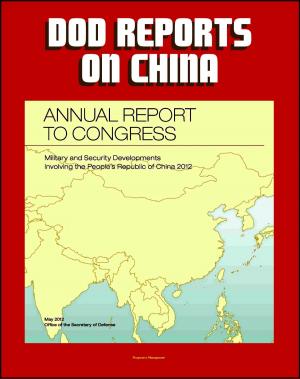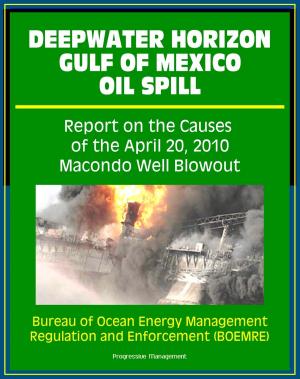Emergency Support Function 15: Communication Synchronization during Defense Support of Civil Authorities Operations - Whole-of-Government External and Public Affairs, Lessons from 9/11 and Katrina
Nonfiction, Social & Cultural Studies, Political Science, Social Science| Author: | Progressive Management | ISBN: | 9780463339800 |
| Publisher: | Progressive Management | Publication: | May 4, 2018 |
| Imprint: | Smashwords Edition | Language: | English |
| Author: | Progressive Management |
| ISBN: | 9780463339800 |
| Publisher: | Progressive Management |
| Publication: | May 4, 2018 |
| Imprint: | Smashwords Edition |
| Language: | English |
This excellent report has been professionally converted for accurate flowing-text e-book format reproduction.
In response to 9/11 and Hurricane Katrina, there were a number of shortfalls that surfaced in interagency coordination and jurisdictional boundaries such as poor information sharing, confused relationships, unclear understanding of roles and responsibilities and leadership challenges. The Emergency Support Function (ESF) 15 Standard Operating Procedures (SOP) incorporates the following five components: Public Affairs, Joint Information Center (JIC), Congressional Affairs, Public Information Plans and Products, Intergovernmental Affairs, and the private sector aspects of external affairs. The purpose of the ESF 15 Communication Synchronization program evaluation phenomenological study is to understand the lived experiences of federal (to include military), state, and local interagency public affairs officers the FEMA VII U.S. Midwestern Region area of responsibility and to explore the effect of the ESF 15 communication synchronization during Defense Support of Civil Authorities (DSCA) operations.
CHAPTER 1 INTRODUCTION * Problem Background * Problem Statement * Purpose of the Study * Research Questions * Significance of the Research * Significance to Leadership * Limitations * Delimitations * Theoretical Framework * Operational Definitions * Summary * CHAPTER 2 LITERATURE REVIEW * Communication Synchronization * National Response Framework * National Incident Management System * Public Information * Emergency Support Function 15: External Affairs * U.S. Army National Guard Dual Status Commander * DOD Critical Planning Factors to Support Domestic Law Enforcement Agencies * Crisis-Communication Strategy * Emergency Response and Business Continuity: The Next Generation in Planning * Information Intermediaries for Emergency Preparedness and Response: A Case Study from Public Health * Effective Emergency Management: A Closer Look at the Incident Command System * Hurricane Sandy Communication Synchronization Analysis * Theoretical Framework * Rational Choice Theory * Institutional Theory * Interagency Coordination Concepts * Whole-of-Government Approach * Inter-Organizational Collaboration Approach * Summary * CHAPTER 3 METHODOLGY * Research Questions * Research Design * Population, Sample, and Sampling Procedure * Population * Sample * Sampling Procedure * USARNORTH PAO * Fort Hood Public Affairs Detachment * FEMA Region VII PAO * Missouri National Guard PAO * State of Nebraska PAO * Douglas County PAO * City of Lawrence PAO * Location * Consent * Instrumentation * Procedures and Measures * Data Analysis * Methodological Assumptions, Limitation, and Delimitations * Methodological Assumptions * Limitations * Delimitations * Summary * CHAPTER 4 PRESENTATION AND ANALYSIS OF DATA * Purpose of the Study * Research Questions * Review of the Data Collection Procedures * Program-Related Documents * Open-ended Interviews with ESF 15 Communication Synchronization Stakeholders * ATLAS Software * Findings * ESF 15 Communication Synchronization Stakeholder Impressions * ESF 15 Communication Synchronization Stakeholder Personal Experiences * Supporting Question Results * ESF 15 Communication Synchronization Understanding . * ESF 15 Communication Synchronization Experience. * Summary * CHAPTER 5 CONCLUSIONS AND RECOMMENDATIONS * Purpose of the Study * Summary of Findings. * ESF 15 Communication Synchronization Stakeholder Impressions. * ESF 15 Communication Synchronization Stakeholder Personal Experiences * Supporting Question Results * ESF 15 Communication Synchronization Understanding * ESF 15 Communication Synchronization Experience * Discussion * Ethical Concerns * Implications * Conclusions * Recommendations for ESF 15 SOP Stakeholder Leadership and Policy Makers * Recommendation for Future Study * Limitations * Summary * GLOSSARY * APPENDIX A STRUCTURED QUESTIONNAIRE * APPENDIX B INFORMED CONSENT
This excellent report has been professionally converted for accurate flowing-text e-book format reproduction.
In response to 9/11 and Hurricane Katrina, there were a number of shortfalls that surfaced in interagency coordination and jurisdictional boundaries such as poor information sharing, confused relationships, unclear understanding of roles and responsibilities and leadership challenges. The Emergency Support Function (ESF) 15 Standard Operating Procedures (SOP) incorporates the following five components: Public Affairs, Joint Information Center (JIC), Congressional Affairs, Public Information Plans and Products, Intergovernmental Affairs, and the private sector aspects of external affairs. The purpose of the ESF 15 Communication Synchronization program evaluation phenomenological study is to understand the lived experiences of federal (to include military), state, and local interagency public affairs officers the FEMA VII U.S. Midwestern Region area of responsibility and to explore the effect of the ESF 15 communication synchronization during Defense Support of Civil Authorities (DSCA) operations.
CHAPTER 1 INTRODUCTION * Problem Background * Problem Statement * Purpose of the Study * Research Questions * Significance of the Research * Significance to Leadership * Limitations * Delimitations * Theoretical Framework * Operational Definitions * Summary * CHAPTER 2 LITERATURE REVIEW * Communication Synchronization * National Response Framework * National Incident Management System * Public Information * Emergency Support Function 15: External Affairs * U.S. Army National Guard Dual Status Commander * DOD Critical Planning Factors to Support Domestic Law Enforcement Agencies * Crisis-Communication Strategy * Emergency Response and Business Continuity: The Next Generation in Planning * Information Intermediaries for Emergency Preparedness and Response: A Case Study from Public Health * Effective Emergency Management: A Closer Look at the Incident Command System * Hurricane Sandy Communication Synchronization Analysis * Theoretical Framework * Rational Choice Theory * Institutional Theory * Interagency Coordination Concepts * Whole-of-Government Approach * Inter-Organizational Collaboration Approach * Summary * CHAPTER 3 METHODOLGY * Research Questions * Research Design * Population, Sample, and Sampling Procedure * Population * Sample * Sampling Procedure * USARNORTH PAO * Fort Hood Public Affairs Detachment * FEMA Region VII PAO * Missouri National Guard PAO * State of Nebraska PAO * Douglas County PAO * City of Lawrence PAO * Location * Consent * Instrumentation * Procedures and Measures * Data Analysis * Methodological Assumptions, Limitation, and Delimitations * Methodological Assumptions * Limitations * Delimitations * Summary * CHAPTER 4 PRESENTATION AND ANALYSIS OF DATA * Purpose of the Study * Research Questions * Review of the Data Collection Procedures * Program-Related Documents * Open-ended Interviews with ESF 15 Communication Synchronization Stakeholders * ATLAS Software * Findings * ESF 15 Communication Synchronization Stakeholder Impressions * ESF 15 Communication Synchronization Stakeholder Personal Experiences * Supporting Question Results * ESF 15 Communication Synchronization Understanding . * ESF 15 Communication Synchronization Experience. * Summary * CHAPTER 5 CONCLUSIONS AND RECOMMENDATIONS * Purpose of the Study * Summary of Findings. * ESF 15 Communication Synchronization Stakeholder Impressions. * ESF 15 Communication Synchronization Stakeholder Personal Experiences * Supporting Question Results * ESF 15 Communication Synchronization Understanding * ESF 15 Communication Synchronization Experience * Discussion * Ethical Concerns * Implications * Conclusions * Recommendations for ESF 15 SOP Stakeholder Leadership and Policy Makers * Recommendation for Future Study * Limitations * Summary * GLOSSARY * APPENDIX A STRUCTURED QUESTIONNAIRE * APPENDIX B INFORMED CONSENT















